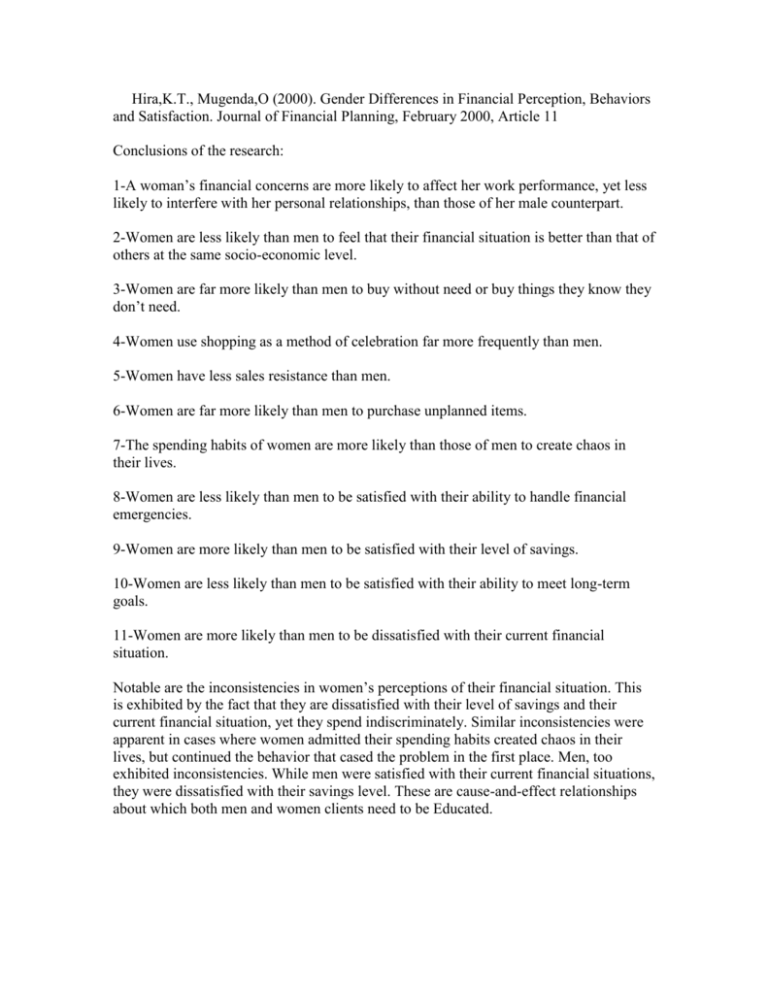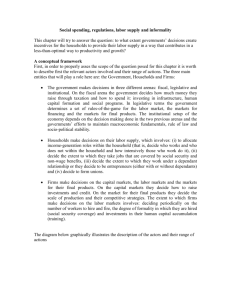Compulsive Buying
advertisement

Hira,K.T., Mugenda,O (2000). Gender Differences in Financial Perception, Behaviors and Satisfaction. Journal of Financial Planning, February 2000, Article 11 Conclusions of the research: 1-A woman’s financial concerns are more likely to affect her work performance, yet less likely to interfere with her personal relationships, than those of her male counterpart. 2-Women are less likely than men to feel that their financial situation is better than that of others at the same socio-economic level. 3-Women are far more likely than men to buy without need or buy things they know they don’t need. 4-Women use shopping as a method of celebration far more frequently than men. 5-Women have less sales resistance than men. 6-Women are far more likely than men to purchase unplanned items. 7-The spending habits of women are more likely than those of men to create chaos in their lives. 8-Women are less likely than men to be satisfied with their ability to handle financial emergencies. 9-Women are more likely than men to be satisfied with their level of savings. 10-Women are less likely than men to be satisfied with their ability to meet long-term goals. 11-Women are more likely than men to be dissatisfied with their current financial situation. Notable are the inconsistencies in women’s perceptions of their financial situation. This is exhibited by the fact that they are dissatisfied with their level of savings and their current financial situation, yet they spend indiscriminately. Similar inconsistencies were apparent in cases where women admitted their spending habits created chaos in their lives, but continued the behavior that cased the problem in the first place. Men, too exhibited inconsistencies. While men were satisfied with their current financial situations, they were dissatisfied with their savings level. These are cause-and-effect relationships about which both men and women clients need to be Educated. Carrier,L., Maurice, D. Beneath the Surface: the Psychological Side of Spending Behaviors. Journal of Financial Planning, February 1998, Article 14. 1-According to social learning theory, spending behavior often transmitted by parents and other influential individuals, and is, therefore, predominantly one that is passed from generation to generation. D’Astous and Fortier(1988), suggest that during early childhood human beings either are or are not successful in learning to manage time, space, resources and impulses. It is reasonable to assume that spending patterns and the expectation of EMOTIONAL rewards resulting from spending also are learned in childhood. 2-Like any other compulsive behaviour, dysfunctional money behaviors often have their roots in messages from childhood, verbal or non-verbal, associated with money and spending. Mixed messages typify these roots. The following are commom examples of mixed money messages we may have received: -Money can’t buy happiness. -Diamonds area girl’s best friend. -Don’t marry for money. -It’s just as easy to love a rich man as a poor one. -Follow the money. -The love of money is the root of all evil. 3-People who are addicted to money and possessions usually have severely damaged egos. Possesions give them “identity”. Overspending behaviors can involve over-use of credit, compulsive gambling, irrational obsession with the stock market, or a need to spend money to create a mood change. Mood-changing motives could include quieting anxieties or lifting depression and elevating self-esteem. 4- Fierman(1995) says these people are self-medicating their depression by spending compulsively. The act of buying makes them feel important, attractive, fulfilled. It helps some reconnect with their feelings-others to escape them. They look forward to the attention paid them by appreciative sales people and they revel in the moment when the sale is consummated.








